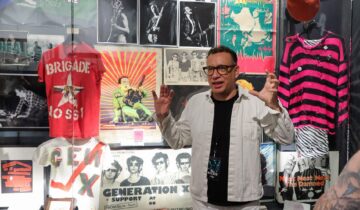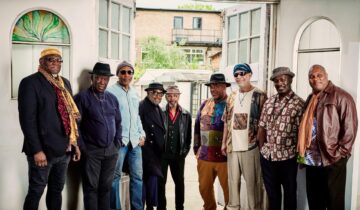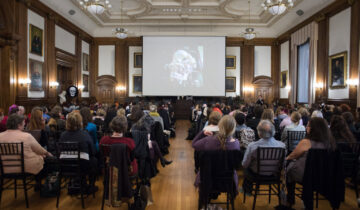 For SF Weekly: Residents filled the six or more rows of seats in room 400 at City Hall on March 19, while a dozen or more folks wearing “I support #sfnightlife” stickers stood shoulder to shoulder along the far wall. Others trickled in and out, occasionally bumping into the electronic button on the wall, opening the automatic door, and dumping disruptive hallway noise into the Planning Commission meeting.
For SF Weekly: Residents filled the six or more rows of seats in room 400 at City Hall on March 19, while a dozen or more folks wearing “I support #sfnightlife” stickers stood shoulder to shoulder along the far wall. Others trickled in and out, occasionally bumping into the electronic button on the wall, opening the automatic door, and dumping disruptive hallway noise into the Planning Commission meeting.
Music venue owners and managers, bar and restaurant owners, neighborhood group organizers, and artists and musicians had gathered for one reason: tell Planning Commission members they support proposed legislation that aims to protect San Francisco’s nightlife from being pushed out by swift, large-scale development happening largely in mixed-use neighborhoods where entertainment venues have operated for decades but residential spaces are relatively new.
From a podium facing the commission members, Dennis Juarez, owner of Slim’s, called the city’s latest round of developers “carpetbaggers with no stake in the community,” and told commissioners he wished the legislation would have been passed four years ago. Many in the crowd reluctantly laughed, aware that Juarez has spent years dealing with a noise complaint that ballooned into a legal battle causing Slim’s — a live music venue that’s operated since 1988 — to close for two weeks and spend six figures on sound attenuation. As he continued to speak, Juarez’s voice began to quiver.
“San Francisco has been a hub for live music for 150 years,” Juarez said. “If I were you, I wouldn’t want to know that things changed on my watch.”
As the second tech bubble has brought vast amounts of people and money to San Francisco, demand for a finite amount of available land has skyrocketed. Development has swept through the city swiftly, particularly in mixed-use neighborhoods that combine residential and commercial spaces in close proximity. Areas where nightlife and places of entertainment have existed for decades are now also home to new condominiums, filled with more and more residents who — as head-scratching as it may seem — are complaining about noise after they move in.
Slim’s is merely one in a long list of entertainment venues that have closed temporarily or permanently, or sold in direct response to city development in mixed-use neighborhoods. Such development is happening quickly, often with little or no oversight with regard to noise. Cafe Cocomo in Dogpatch, Cafe du Nord in Upper Market, The Lexington in the Mission, Red Devil Lounge, and The Sound Factory are some that have changed hands, closed, or are set to close. Other venues, including the Elbo Room, Bottom of the Hill, and the Independent continue to negotiate real or potential changes brought on by approved and proposed building projects in their neighborhoods.
When area news stories popped up about condominiums replacing an old radiator shop near the Independent, Supervisor London Breed and her staff started looking at the issue. They met with members of the Entertainment Commission, Planning Commission, and police through fall 2014, and Breed introduced legislation in December. Several unanimous approval votes then occurred with the Small Business Commission, Entertainment Commission, a building and inspection hearing, and then the March 19 Planning Commission meeting. Breed’s legislation moves on to the Land Use Commission this month before coming before the Board of Supervisors and ultimately the mayor as early as mid-May, according to Breed’s staff.
“The soul of this city is just changing so fast, whether it’s a Google bus or whatever else,” said Jocelyn Kane, executive director of the Entertainment Commission. “It’s different now from what we saw in the ’90s, with the amount of money, and the sustained amount of change. This legislation is important because it forces project sponsors to come talk to us and get our signoff.”
Breed’s legislation aims to prevent noise disputes by improving relationships between venues and neighbors, and working more closely with developers who are building new residential properties close to music venues. The legislation would help prevent venues from being shut down if they are operating within city entertainment permits, requires developers to work with venues before they begin construction, and ensures that all potential tenants of a new development know about local entertainment venues before they move in. It also asks developers to include sound attenuation specifics in their development plans for new housing.
Supporters of the bill are quick to say they are not opposed to citywide development, but are eager to put Breed’s legislative controls in place to proactively mitigate noise complaints.
When Guy Carson bought the live music venue Cafe du Nord in 2003, he had previously managed the music venue Hotel Utah, and had been a professional musician for more than 20 years. He and his partners were serious about music. At Cafe du Nord, they booked act they thought were “important,” as eclectic as the market would bear — from Donovan to a reunited Sebadoh, indie-folk act Sea of Bees to pop-punk poster-boys Blink 182. It was music the owners thought people should see, regardless of the profitability.
“When we first moved out there, it was like the Wild West,” Carson told SF Weekly. “There was a gas station, and a parking lot people were fixing their cars in. We pulled our vans in there to unload bands, and nobody complained about it. We essentially provided security for the area, by keeping an eye on things. We brought a lot to that neighborhood.”
Carson sold Cafe du Nord in January 2014 when developers at the corner of Sanchez and Market agreed to add 225 new residences. The building needed repairs he and his partners couldn’t afford. At the tail end of a four-year recession, they had been hit hard, and all those new neighbors coming in was a scary prospect. The building project was part of the larger Market Octavia Area plan, a Better Neighborhoods Program initiative designed to help areas along Market Street from Van Ness to Octavia become more of a “vibrant urban place,” with potential for new mixed-use development, including a significant amount of new housing aimed at attracting “a wide range of people both day and night.”
“Things are changing,” Carson said. “It’s free enterprise at work. When I came to town in 1984, all these musicians and artists were doing wild and wacky things, like marching up and down Market with huge dildos. For a young musician, it was like nirvana. It’s the same energy now, just more focused on tech and money than arts and music.”
When John Vanderslice moved to San Francisco in 1989, he could walk down Hayes near Webster and bands would be playing in backyard parties that nobody complained about. An avid hiker and backpacker, he fell in love with the open space surrounding the city. The history of tech and audio in San Francisco was also a draw: After playing for years with the Bay Area band Mk Ultra, Vanderslice opened Tiny Telephone, an analog recording studio in the Mission, where he has gone on to record and produce albums from a long list of alternative and mainstream bands, including Death Cab for Cutie and Spoon, as well as his own albums.
From the beginning, Vanderslice liked that San Francisco was a gay city, a magnet for people who maybe felt a little crazy or outcast elsewhere but felt reassured by being here. The history of Berkeley, free speech, and the Black Panthers all mattered to him politically. It was not the stuff of Jacksonville, Fla., where he grew up.
“Money can make stuff uncoil,” Vanderslice said. “Go to Carmel. It’s pretty but kind of suicide-inducing. There are deeper and more profound structurally unfair things happening here now. Gentrification and tech, that is stuff that happens in cities, but there are extremely unfair divisions between poverty and wealth here. Without some sort of sane middle class, there is going to be a Disneyland aspect to the hipper parts of town. There’s so many bars, but they’re filled with so many more dummies. Look at North Beach; you can’t go there on the weekend. It’s bridge and tunnelers who just go there to fight on Columbus Avenue. It’s insane.”
Plans to build a dozen or so condominiums and retail spaces on the site of an old radiator repair shop next to the Independent on Divisadero sent up red flags immediately to the venue’s owners when the idea surfaced last year. They have since taken steps proactively that essentially mirror what Breed’s legislation calls for. Meetings were held with the developers and neighborhood association members, acoustic engineers have done sound readings outside the building to determine what sound attenuation may be necessary, and legally binding agreements, which would notify all prospective tenants that they are next to a nightclub, have been discussed.
“These nightclubs are the fabric of this city, going back to the ’60s,” said Allen Scott, executive vice president of Another Planet Entertainment and a managing owner of the Independent. “If clubs shut down, I guarantee another club will not go into that spot. It will become condos or some sort of living space. It’s integral that we save the clubs in this town, or they’ll go to Oakland, Berkeley, or San Jose.
Many have floated the idea of granting historical status to some of the city’s live music venues in an effort to protect them from being removed. Not surprisingly, neighborhood associations have largely stepped up on behalf of venues potentially threatened by development. At the March 19 meeting, the North of the Panhandle Neighborhood Association spoke of the Independent’s efforts to help mobilize residents of the area, not just in response to developers but also after a four-alarm fire on nearby McCallister Street in January. Members of the Potrero Hill Boosters, Merchants’ Association, and the Save the Hill organization in Potrero Hill regularly call meetings with developers. Save the Hill ran a “Kaiser: Bad Medicine” campaign to prevent Kaiser from moving in near the music venue Bottom of the Hill, according to Ramona Downey, a talent buyer and co-owner of the venue, which opened in 1991 and typically hosts live music seven nights a week.
“When Bottom of the Hill opened, people said, ‘You are so far out, nobody will go there,’ but we had parking because we were on the edge of an industrial neighborhood,” Downey said. “We are just kind of there by ourselves, a little venue, not a large company. We know the development is coming, and we won’t be able to stop it. But we have clout there, and we should have some power in how they structure development.”
To Terrance Alan, this new round of noise wars may feel like déjà vu: the latest in an ongoing battle to save space in San Francisco for nighttime entertainment. Alan led the initial implementation of the Entertainment Commission, which formed in the wake of a mixed-use battle in SOMA that had its origins in the warehouse parties of the early EDM scene in the ’90s.
Underground promoters were throwing events that were continuously interrupted and shut down by local police, who said the promotors lacked proper permits, according to Alan. The Late Night Coalition was formed to better enable negotiations between promoters and law enforcement.
“There was a lot of anger and emotion. We were confused and upset, and there was a standoff,” Alan said. “Then there was a dawning moment: If you don’t like the rules, especially here in San Francisco, you have the ability to effect change. The Late Night Coalition was able to represent the right to party very quickly.”
Without proper legislation like the one Breed has proposed, the burden of protecting noise — after noise has been determined to be a public nuisance — has typically defaulted not to developers or property owners but to nightclubs, according to Alan. During the first wave of dot-com development, proper sound mitigation was not factored into the construction of live-work spaces common in that era. But as others have moved to those places, they’ve found themselves with no soundproofing against city noise: screeching cars, people, music. Alcoholic Beverage Control policy, which monitors venues that serve booze, simply claims that “no noise shall be audible beyond the area under control of the licensee.”
“Even though a venue is complying with noise regulations, one neighbor who complains can shut a whole venue down,” Alan said. “There is an underlying principle in law that says your home is your castle. If your home is being disturbed, you can do something about it. The theory is that nightclubs are always wrong, and residents always right. But it’s like, why do people move near airports and then immediately try to shut them down?”
Alan and other members of the California Music and Arts Coalition argue that construction of new residences in mixed-use neighborhoods should be built to withstand the environment, and that it’s a waste of resources to have to fix the problem after people have already moved in.
A 2012 study from the city’s Office of Economic Analysis found that San Francisco’s Nightlife Industries generated roughly $4.2 billion in 2010. The local industry (at the time) included 3,200 businesses employing 48,000 workers who served roughly 80 million spending customers annually. The report was eye-opening for many city officials.
“When [Supervisor Scott] Weiner came out with that economic impact report, it changed people’s attitudes toward nightlife and entertainment,” Alan said. “People realized it’s not a nuisance. It makes more sense for a developer building a gazillion-dollar building to spend an extra $100 on soundproofing.”
More than 3,000 people have signed a petition created by Ben Bleiman titled “Save San Francisco’s Nightlife From Developers,” which supports Breed’s proposed legislation. Many of the signees attended the March 19 meeting. “I don’t want S.F.’s rapid, frenzied development to destroy our world-renowned nightlife,” Bleiman writes in the petition.
According to Kane, those involved in San Francisco’s nightlife owe it to themselves to get up to speed on the city’s existing development rules and agendas. The Entertainment Commission holds neighborhood summits which draw up to 300 people, including law enforcement, city planners, and residents. Often discussed are quarterly pipeline reports, which provide maps and detailed descriptions of evictions, and planned development.
“Nobody knows anything until the ground gets broken,” Kane said. “Last year, we said to folks, ‘You have to learn how to navigate this.’ This legislation is important because it forces project sponsors to come to us to talk and get our signoff.
“You think it’s busy now? This ain’t nothing. This city will look a whole lot different in a few years.”
Image: Supervisor London Breed, by Mike Koozmin



